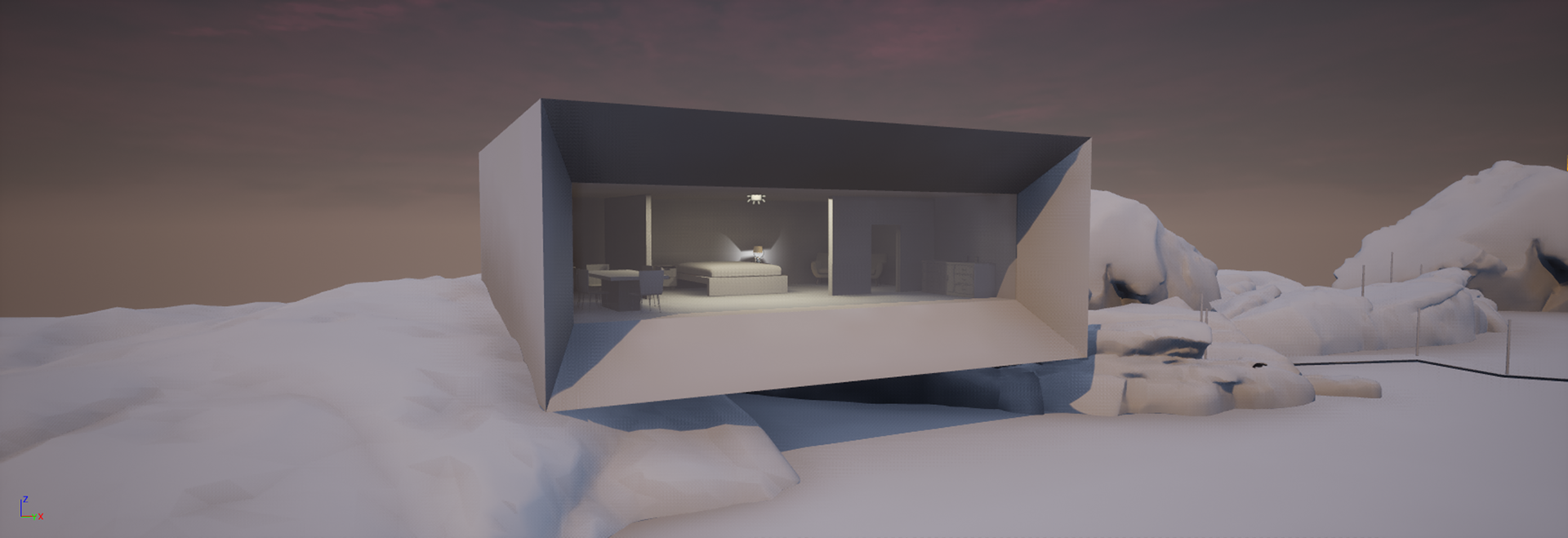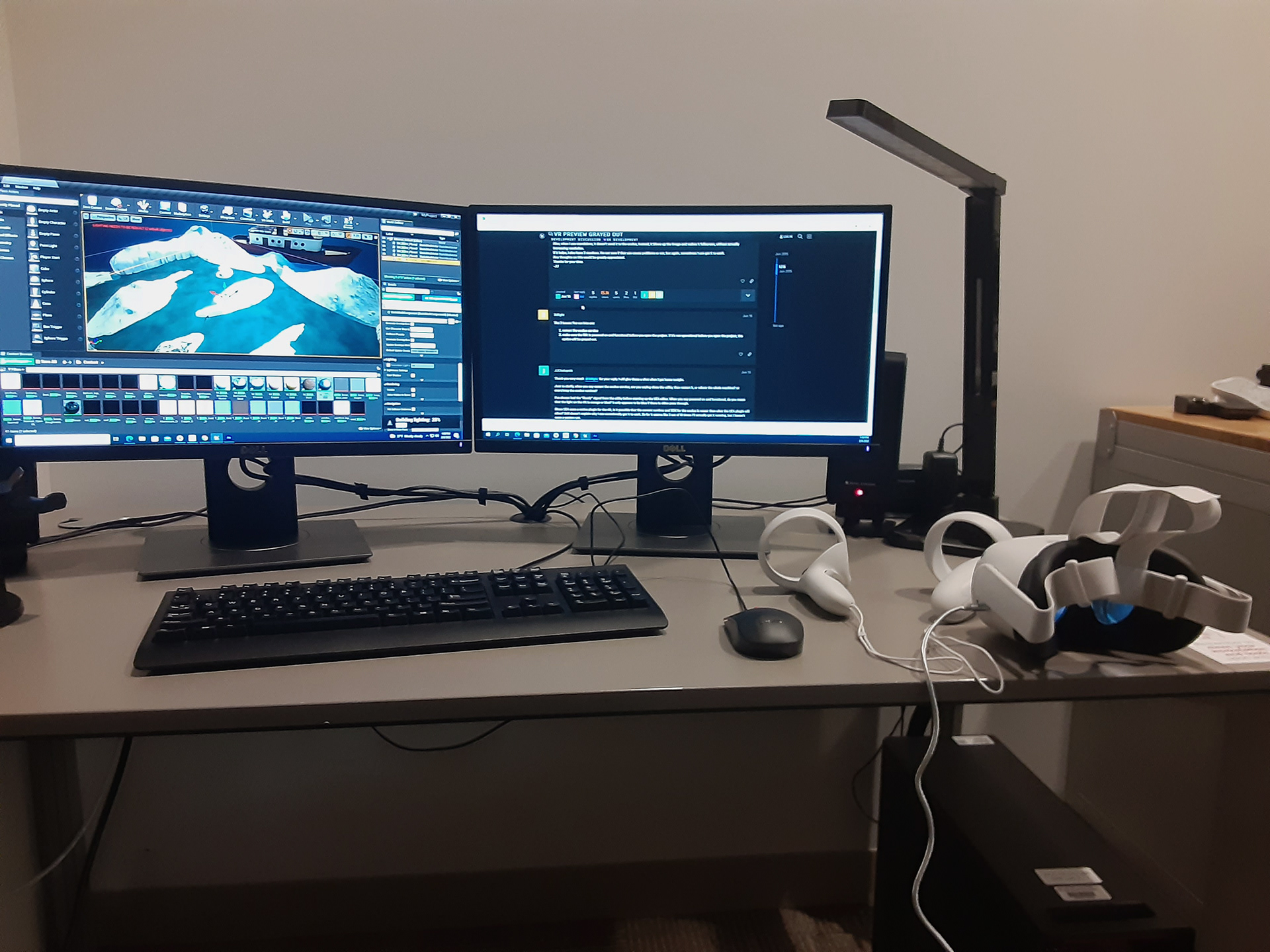Collaboration with Thomas Ellsworth (tsellsworth.myportfolio.com) and
Juan Diego Torres Brenes LaRoche (juandiegotbl.com)
Juan Diego Torres Brenes LaRoche (juandiegotbl.com)
Timeframe: January 2022 - February 2023
Role: Environment Artist
Description: The goal of this project was to create a collaborative VR play experience and attempt to remove some of the isolation that's sometimes experienced by players when engaging with VR environments. We created a game for two players using an Oculus headset attached to a tripod as a 'periscope' to let one player look into the environment and communicate with the other player who has a paper map of the virtual world and access to movement controls. The two players have to coordinate with each other and communicate in person to successfully navigate the environment in a submarine, avoid obstacles, and reach their goal - the lighthouse. To get accustomed to the game mechanics and navigation method, the players are first introduced to a tutorial which is set in a bathtub, and after they complete the short introductory level they move onto the main submarine level, which has multiple routes they can take to the lighthouse. The VR experience was created in Unreal Engine, the 3D assets were modeled using Autodesk Maya and textured using Substance Painter, while the controls were programmed and built with Arduino and a physical joystick.
My contributions: environment design, level design planning, themes + narratives, modeling + texturing assets, designing the paper maps, and assembling + lighting the VR environment in Unreal Engine.
Juan was responsible for setting up a joystick controller to work with Unreal Engine using Arduino and fabricating a physical control panel that contains the working joystick to navigate the levels. Thomas was responsible for level design, playtesting, and game mechanics in Unreal Engine, including player movement, collisions, and the event management system.
The bathtub tutorial level:


The main level:







Players during the ACCAD Open House '23:


One of the issues we encountered during playtesting was that the experience of the person with navigation controls was not as engaging as that of the periscope operator. We approached this problem by adding underwater obstacles (such as rocks) that only the person at the controls can see by looking at the paper map outlining the level layout and the obstacles invisible to the periscope operator. Paper maps of the two levels are used by the player at the controls to help them understand what the periscope operator is seeing and they can help them find the right way. This required including more visual clues by placing the landmarks on the physical map exactly where they appear in the virtual environment so that both players can understand where in the world they are at a given step. For example, the periscope operator tells their partner what landmarks they see, which their partner can locate on the paper map, and warns them if there are underwater obstacles in that area.
Bathtub level paper map (left) and the main submarine level paper map (right):


This project was started at the beginning of 2022 and we worked on the first version for one month. After playtesting and collecting user feedback during events like the ACCAD Playtest Day, we came back to the project a year later and worked on it for an additional month. The feedback from the first version included the environment being too simple (only rocks and sea) and not having many things to look at. It was also a straightforward route instead of being able to choose different paths. We addressed this in the updated level layout that offers a few different routes players can take to reach the lighthouse (brings a decision-making aspect to the game), and I decided to situate the level in an unusual neighborhood in the middle of the ocean and include houses inspired by Brutalist architecture with large windows that players can look through, which brings an exploration aspect to the whole game. The design of the house allows for the placement of interesting landmark items inside - which both players can refer to communicate and orientate themselves. We also decided to switch from Oculus VR hand controllers to a physical control panel. This decision was based on feedback that the controls player's experience was not as engaging as the periscope operator's, so Juan made a much larger controls panel that provides a more immersive experience for the controls player, and it allows them a more intuitive navigation method with a joystick, while they are also looking at the level maps and communicating with the periscope operator.
Juan's in-progress work and the final result on the controls panel and the wire setup embedded in it:
Juan's in-progress work and the final result on the controls panel and the wire setup embedded in it:






Environment lighting-only data:




VR periscope setup:


The first project iteration in progress in 2022:



In-progress level design by Thomas on top of my initial paper prototype:


A poster and role explanation graphics I created for the 2023 ACCAD Open House to showcase our game's story:



